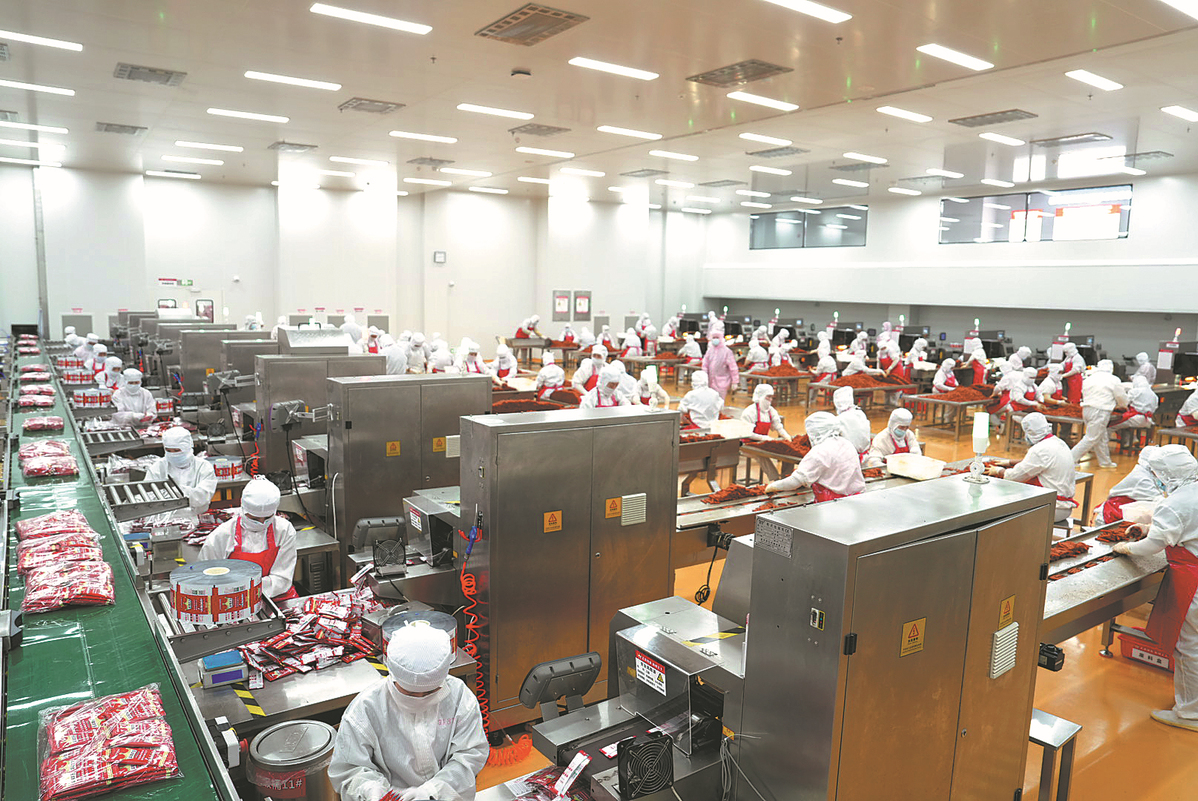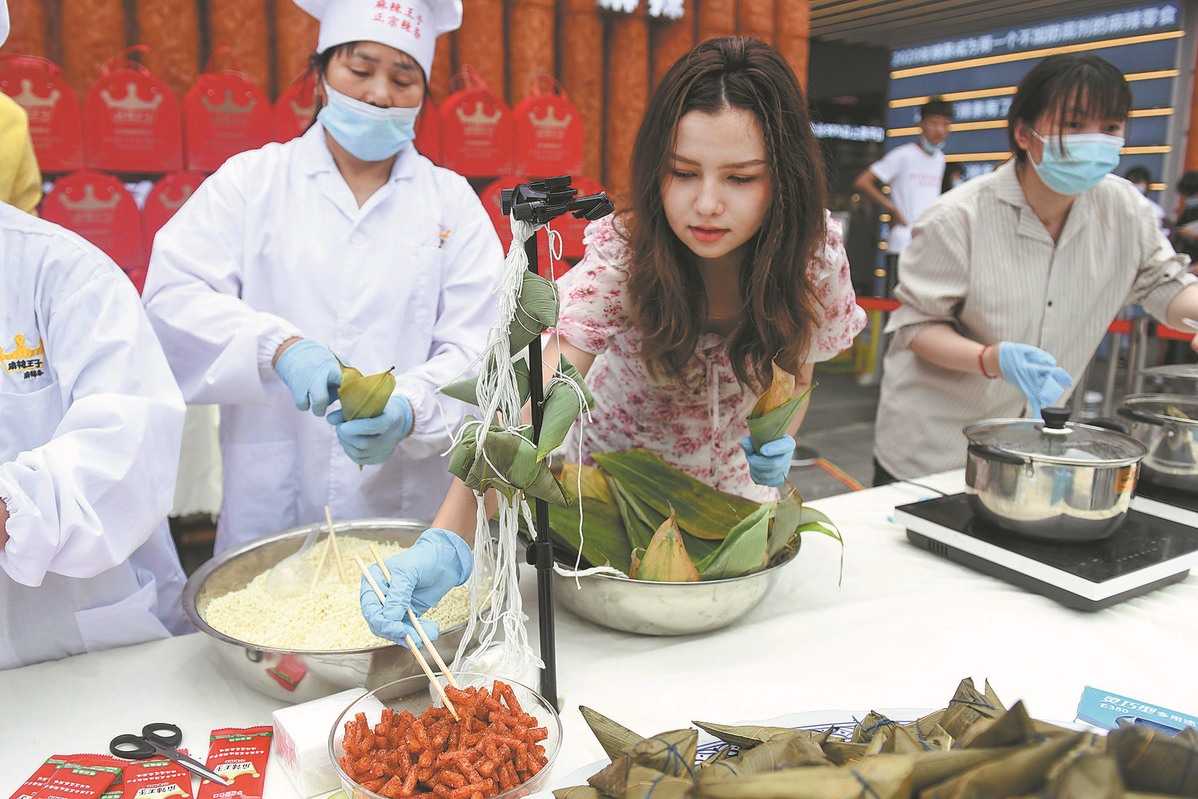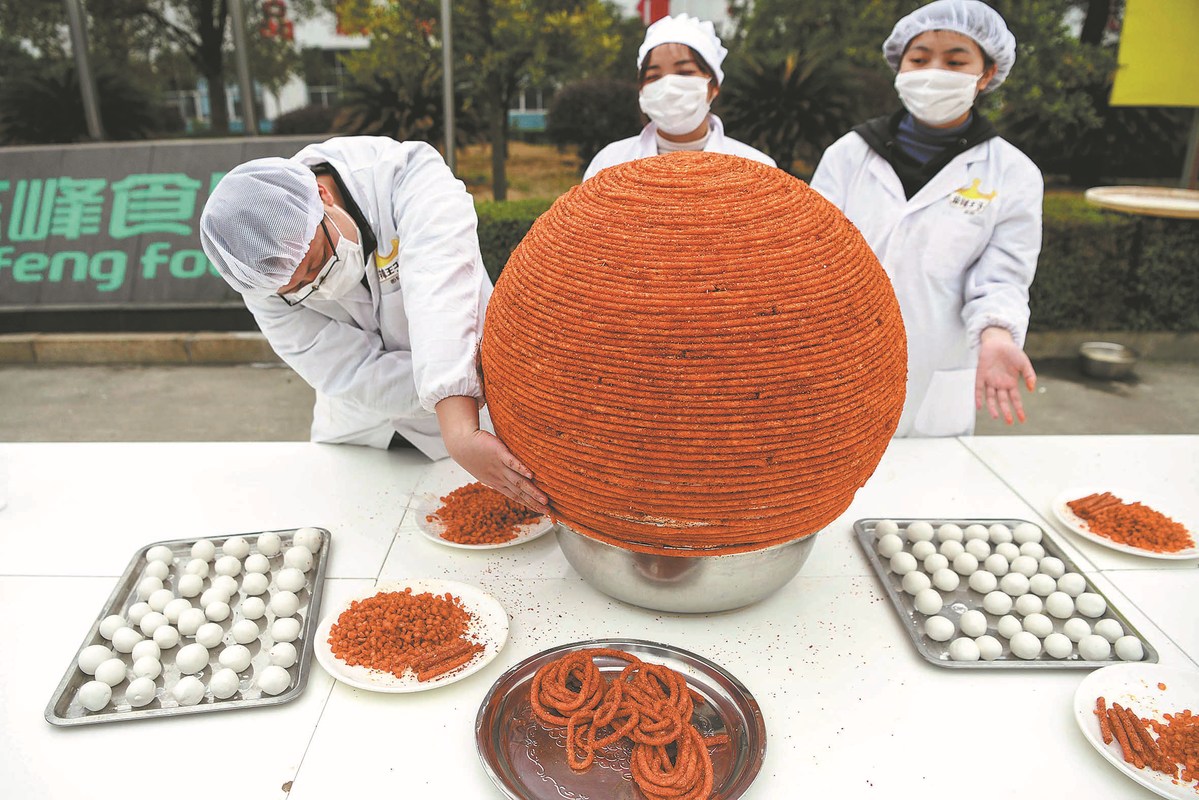Spicy strip cleans up image to conquer snack world

Employees work on the production line of latiao snacks at the Malawangzi factory in Pingjiang county, Hunan. (CHINA DAILY)
Editor's note: In a series of reports titled "Claims to Fame", China Daily looks at how some regions have earned wealth and recognition through specific products to realize the goal of rural vitalization.
Anyone who approaches Malawangzi's snack factory in Pingjiang county, Hunan province, is greeted by the mouthwatering aroma combination of chili pepper, peppercorn, cumin, and cinnamon.
Malawangzi is known for producing latiao, spicy wheat strips that are popular with young people and children. The snack evokes fond childhood memories for many Chinese people.
However, it is also a treat that many parents forbid their children from eating, as it is regarded as unhealthy, greasy, and salty. This unflattering image of the gluten strips is what manufacturers have been striving to change.
There are more than 600 latiao producers in China, and 90 percent of the founders of those companies are from Pingjiang.
Latiao is a 60 billion yuan ($8.37 billion) industry, a third of which is generated in Pingjiang, home to 116 latiao enterprises. The sector employs about 102,000 people — or almost 10 percent — of the county's 1.1 million population.
The fiery snack has caught on around the world and is now sold in 160 countries, including Japan, South Korea, and the United States.
In early July, news that operations at the Malawangzi factory had been suspended due to a flood became one of the highest trending topics on social media platforms.
The flood in Pingjiang affected 340,000 people, with many parts of the county inundated by floodwater from the local river.
No soybeans, no worries
Twenty-six years ago, there was another flood in Pingjiang that led three people to invent the snack.
After the flood devastated the county's soybean farms, soybeans were replaced by more affordable wheat flour to create a new snack inspired by the county's tradition of producing dried bean curds, a culinary dish that dates back to the Qing Dynasty (1644-1911).
The snack was an instant sensation, and many small local food factories in Pingjiang started to make latiao.
Qiu Pingjiang is one of the creators of the snack, and he now works for Malawangzi as a consultant.
"We decided to make latiao because we had to make a living," Qiu said of its invention. "The flood had significantly increased the price of soybeans, so there was no profit in continuing to make the bean curds," he said, adding that's why he and two other villagers started to make latiao.
After the snack increased in popularity, more processing plants opened in other places in China, Qiu said.

A college student learns how to make latiao dumplings on June 11, 2021, for the Dragon Boat Festival. (YANG HUAFENG/CHINA NEWS SERVICE)
"I feel pleased that such a simple snack that is about 8 centimeters long, can be loved by so many people and has brought joy and delight to generations of children."
Qiu is also aware of the snack's negative reputation, which is why he believes the industry must stick to the food safety and quality standards it has implemented.
In 2009, Zhang Yudong founded Malawangzi in a bid to improve the latiao industry's image.
In the early 2000s, there were many small food factories in the county making the popular snack, and the quality of some was not good or was inconsistent, giving the industry a bad name with many people, he said.
In 2013, the company scrapped substandard production lines worth 300 million yuan as it wanted to upgrade the ingredients, packaging, and flavor of its products.
Three years later, Malawangzi started to build the first Good Manufacturing Practice factory, which has quality standards that are the same for making medical products.
"Latiaoused to be treated as a low-end substandard snack and parents did not want their children to eat it, so one of the biggest challenges was to change the negative image of the industry," Zhang said.
Li Manliang, deputy general manager of Malawangzi, said the company has gone to great efforts to make its products healthier by eliminating chemical additives and preservatives. It has also cut the sugar, oil, and salt content in its latiao products to conform with healthier eating habits, he added.
Zhang said he wants latiao to go beyond being a snack and become the Eastern equivalent of chocolate, and be used by young people to express love and emotion.
As part of its marketing strategy, the company has sponsored more than 1,000 weddings, as well as music festivals and even esports competitions to boost interaction with the younger generation, Li said.
The sales revenue of Malawangzi exceeded 1 billion yuan last year, ranking first in both online and offline latiao sales, he said.
The company's sales revenue has seen remarkable growth in recent years, climbing from 200 million yuan in 2020, to 400 million yuan in 2021 and 700 million yuan in 2022, Li said.
Moreover, more than 80 percent of its online sales are from people in the 18 to 28 years age bracket, proving the brand is still a favorite of young people, Li said.

Workers use latiao to make a giant tangyuan on Feb 24, 2021, to celebrate the Lantern Festival, in Pingjiang county. (YANG HUAFENG/CHINA NEWS SERVICE)
Lifeline industry
The latiao industry provides important job opportunities for the county, which was a national-level impoverished county until 2020, according to Li.
As a mountainous county, in the past, many people in Pingjiang had to leave to find jobs in bigger cities. However, the labor-intensive latiao industry has offered locals jobs near their homes, and the opportunity to take care of their children and elderly parents, Li said.
The average salary for Malawangzi workers is about 6,200 yuan per month, a relatively high salary in the county, he said, adding that the industry's development had contributed to local poverty alleviation efforts.
The development has also spurred up and downstream industries, such as machinery manufacturing, packaging, and rapeseed farming.
Chen Gaoqiu and his wife have both been employed at Malawangzi factories for 14 years. They used to work in outside cities to support their family, but the salaries were not high.
The couple can each make 5,000 to 7,000 yuan a month working for Malawangzi.
"We have bought a car, and an apartment and we work near home and look after the family," Chen said. "As a small county, the latiao industry has offered job opportunities for many local people, so we are grateful for the industry."
Li said he is optimistic about the development of the industry. In the past, when its image was poor, people were reluctant to say they worked in the latiao industry, and the government vowed to rein in its development.
"However, as the industry becomes healthier and upgrades, we are more confident about promoting ourselves," he said
Contrary to public perception, latiao is not deep fried. It is cooked by a process known as extrusion puffing, which Li believes makes it a healthy food.
As the company invites more people and government officials to visit its factory, the perception of latiao has changed, he said, adding the local government has also offered more policy support for the industry.
Peng Jinsong, head of another Pingjiang latiao manufacturer, Liren Food, said he started to make spicy food in Wuhan, Hubei province in 1994, before he returned to his hometown in 2005 to look after his elderly parents.
He opened a small food factory that year, and hired a dozen local people. In 2012, he started his latiao enterprise.
His company's sales volume has increased by 30 percent for three consecutive years, reaching 40 million yuan last year.
The company now has 252 employees and it is targeting 80 million yuan sales volume this year, Peng said.
Most of the employees are local villagers and they can make 4,000 to 6,000 yuan per month, he added.
The latiao industry is developing in a more standardized, automated, and healthier way, and also transforming its previously negative image, he said.
"As a Pingjiang person, I want to promote the local latiao snack on a bigger stage," he said. "It is not just a culinary delight, but also a comfort food for many people.
"For me and many other Pingjiang people, the industry is a lifeline so that we can find jobs near our home and take care of our family."

Participants compete in a latiao eating competition in Changsha, Hunan province, on Nov 13, 2021. (YANG HUAFENG/CHINA NEWS SERVICE)
Vocational training
To help train more skilled workers in the latiao industry, the Pingjiang Vocational School has cooperated with Malawangzi since 2020.
The three-year program teaches students how to make latiao, and educates them about food quality and safety as well as marketing strategies. It is the first latiao"major" offered in the country, the school said.
More than 230 students have taken the course in the past four years.
Xiang Weiwei, principal of the vocational school, said it is the school's duty to train skilled workers to participate in the development of the local economy.
Offering specialized training will also help ensure the rapid development of the latiao industry, he said.
In 2023, the first 50 graduates were employed by Malawangzi and other companies in the county, he said.
Graduate Zhang Qi secured a job as a technician with Malawangzi.
He believes his career prospects in the industry are good, and happily admits to being a fan of the snack since childhood.
"I used to secretly eat the snack when I was little because my parents did not allow it," he said. "Now I have learned how to make it, and my appreciation of the snack has deepened."
Zhang said many of his friends envy him because he can now eat as many of the spicy strips as he likes. He is pleased the snack is getting healthier and better quality, which he said gives him a sense of achievement.
Photos
Related Stories
- 9th World Championship of Chinese Cuisine kicks off in Vancouver, Canada
- Traditional Fujian food, cultural event to be held in Singapore
- Ready-made food enterprise expands production overseas
- Trending in China | Fiery Palace stinky tofu
- HainanOutlook | Competition to promote sour rice noodle held in S China
- Crayfish festival ignites summer gourmet feast in east China
Copyright © 2024 People's Daily Online. All Rights Reserved.









